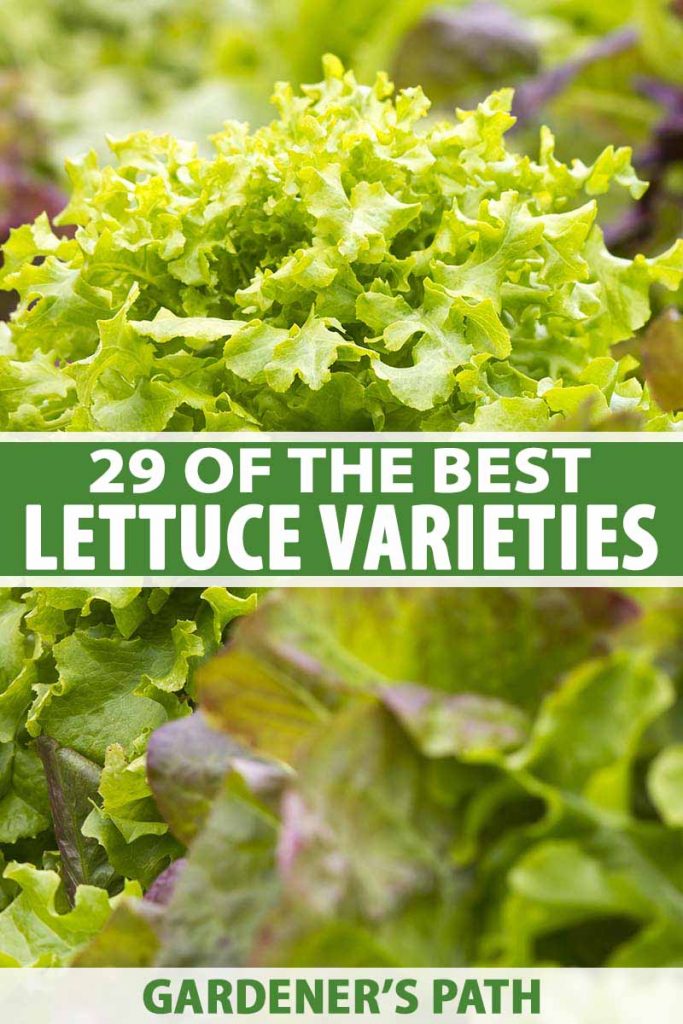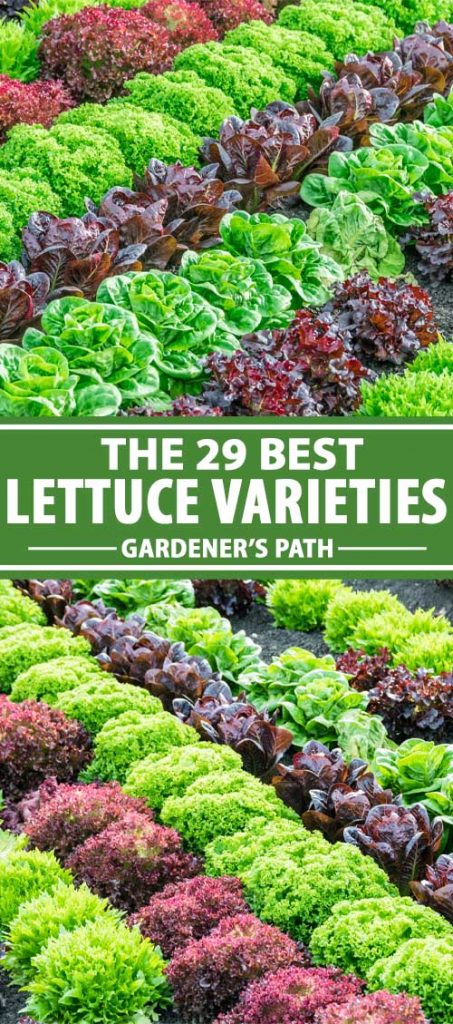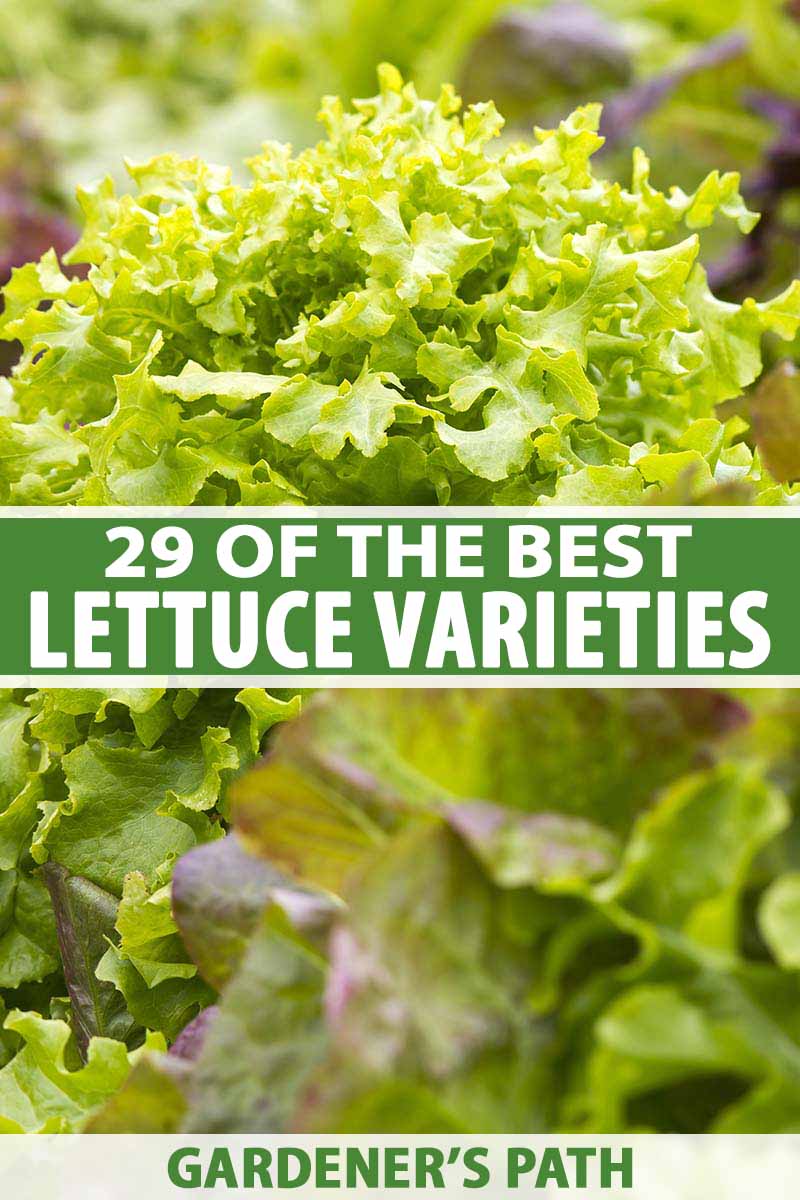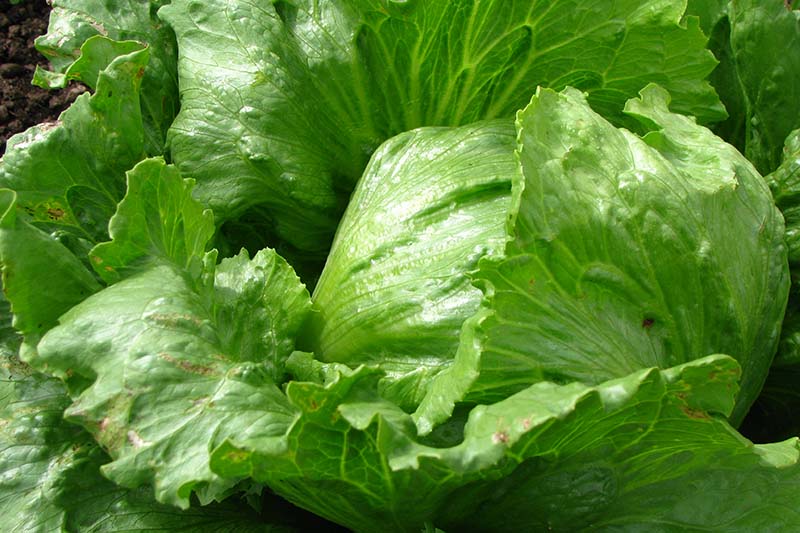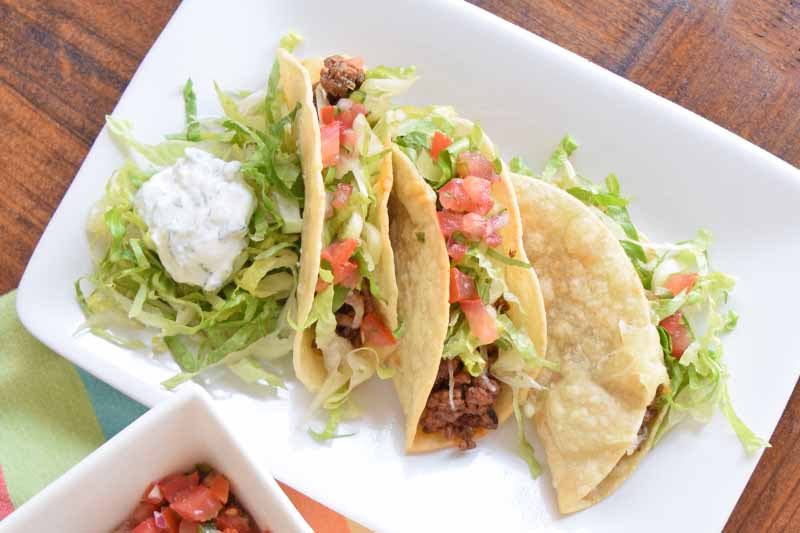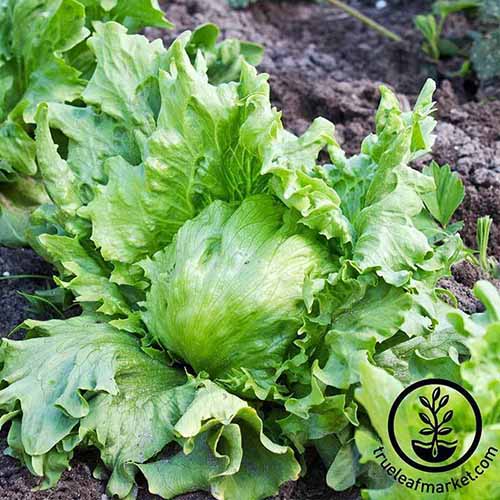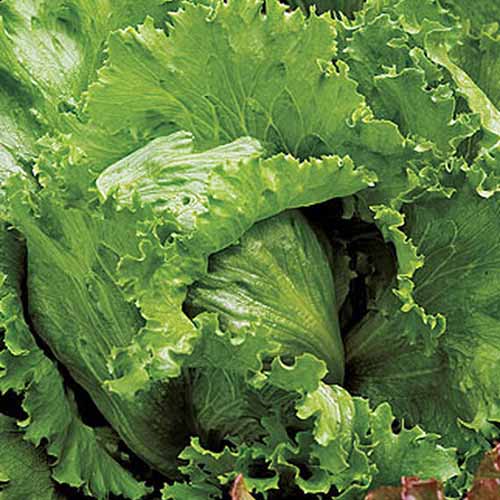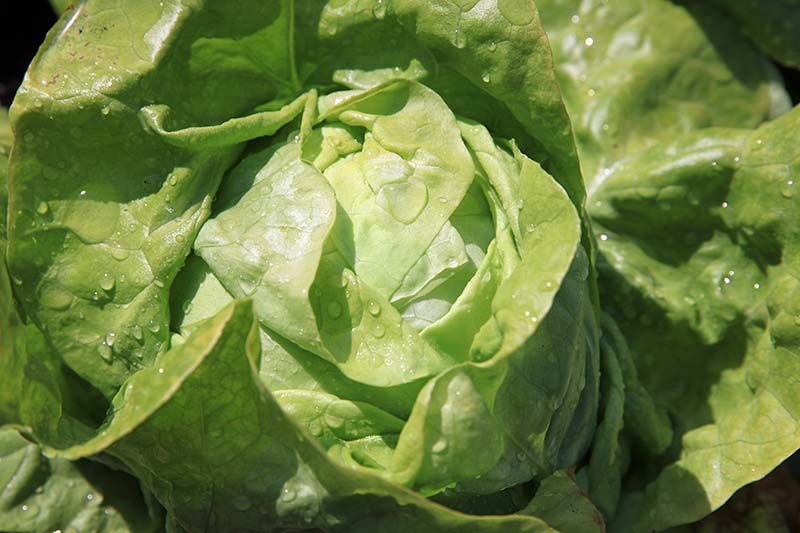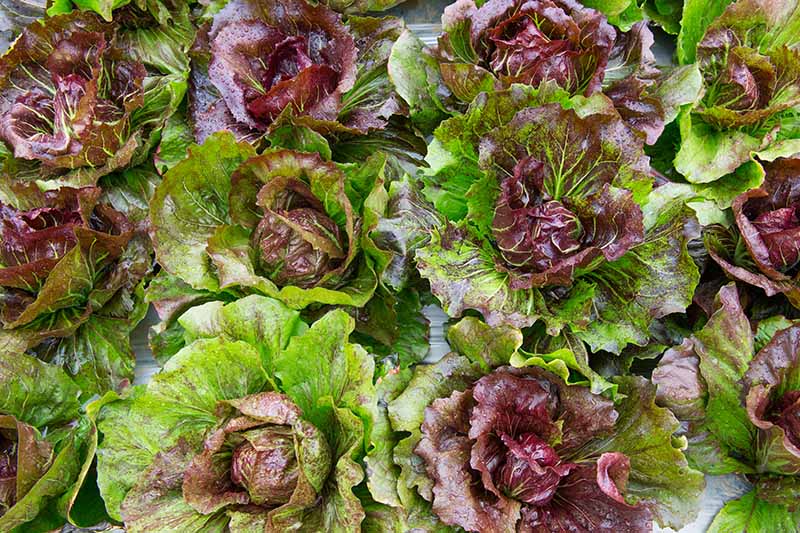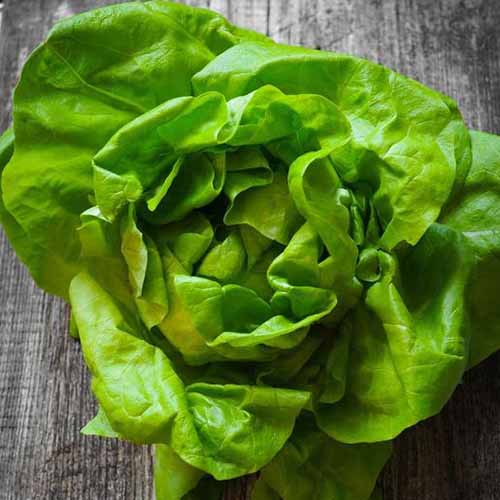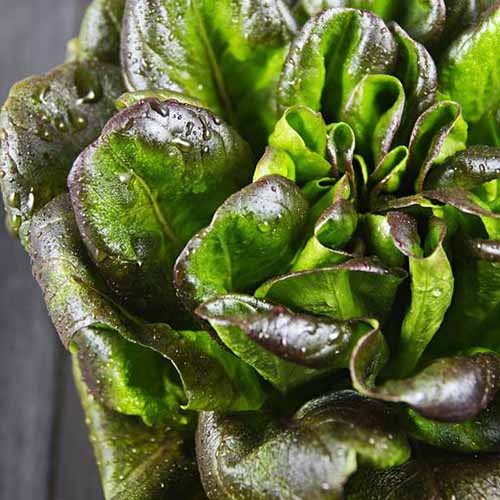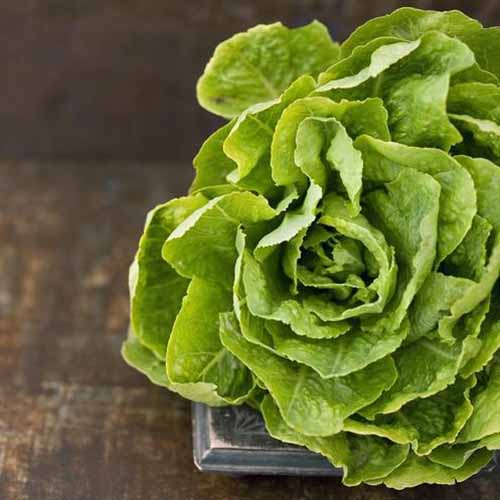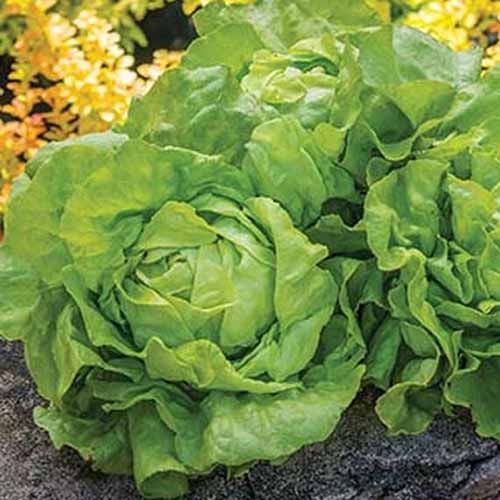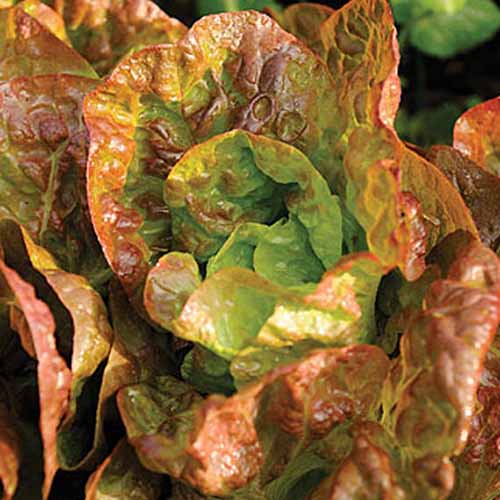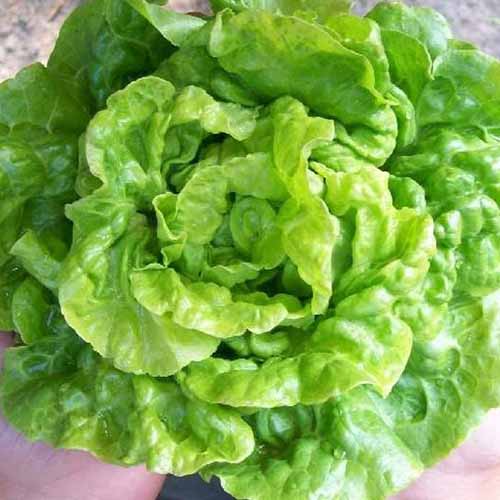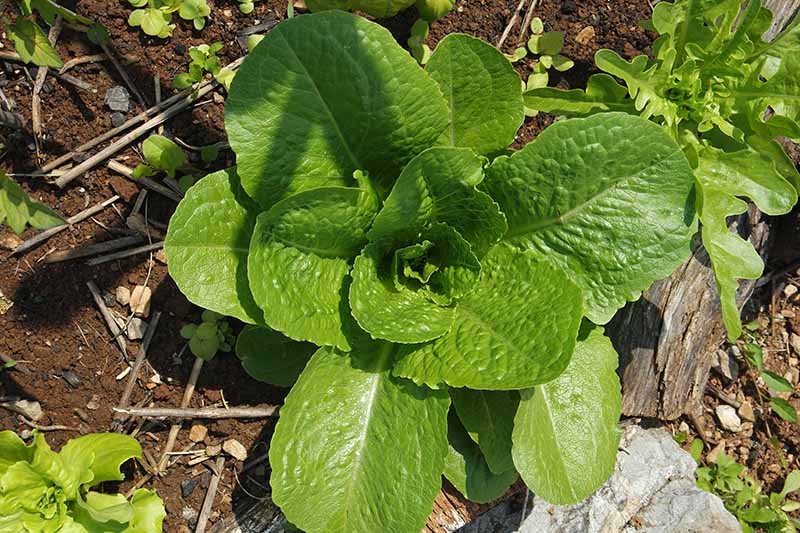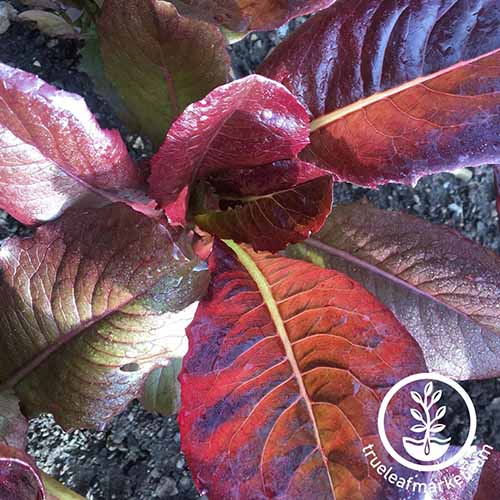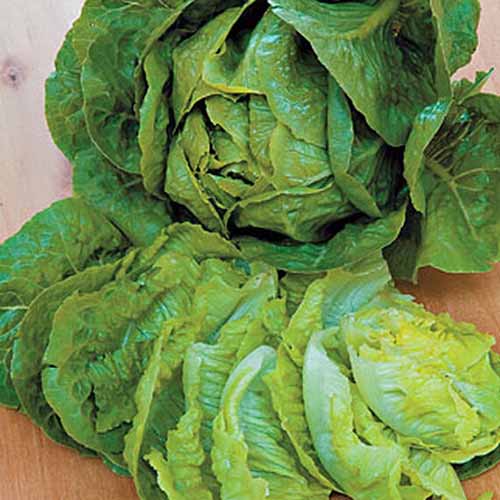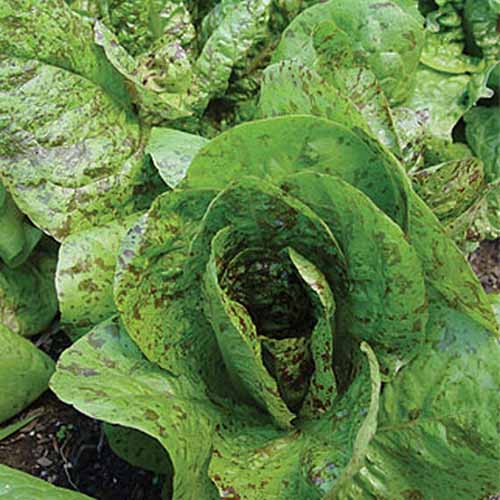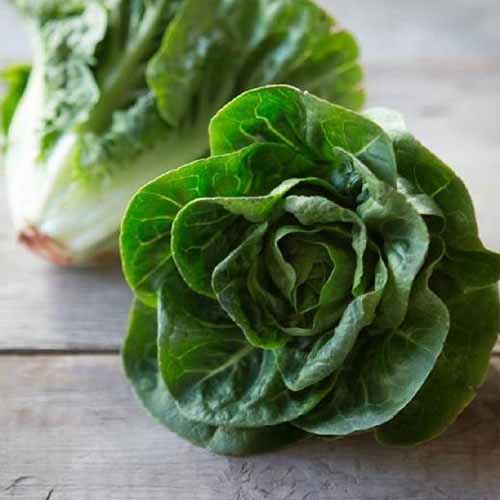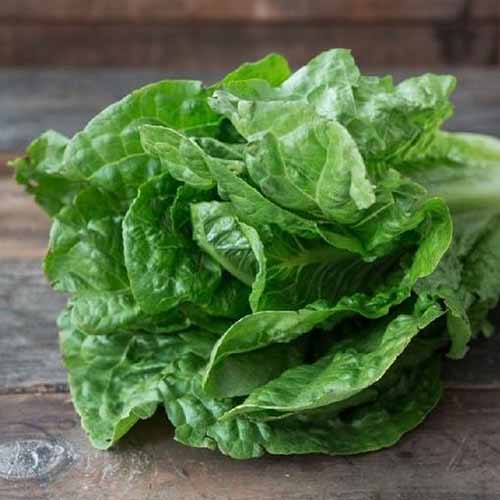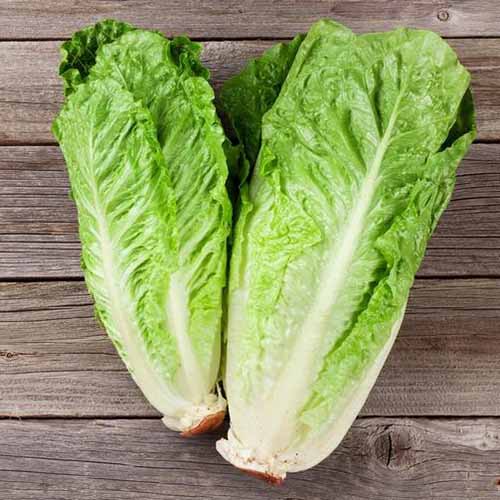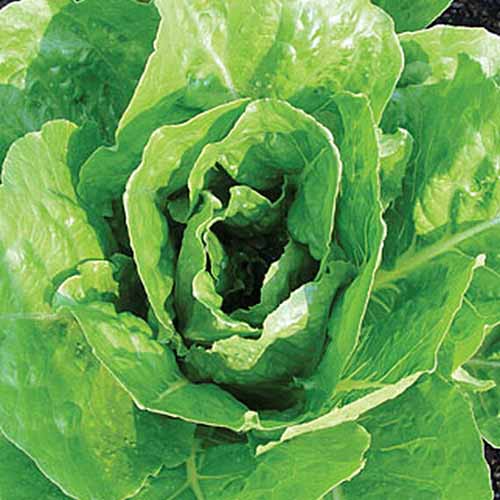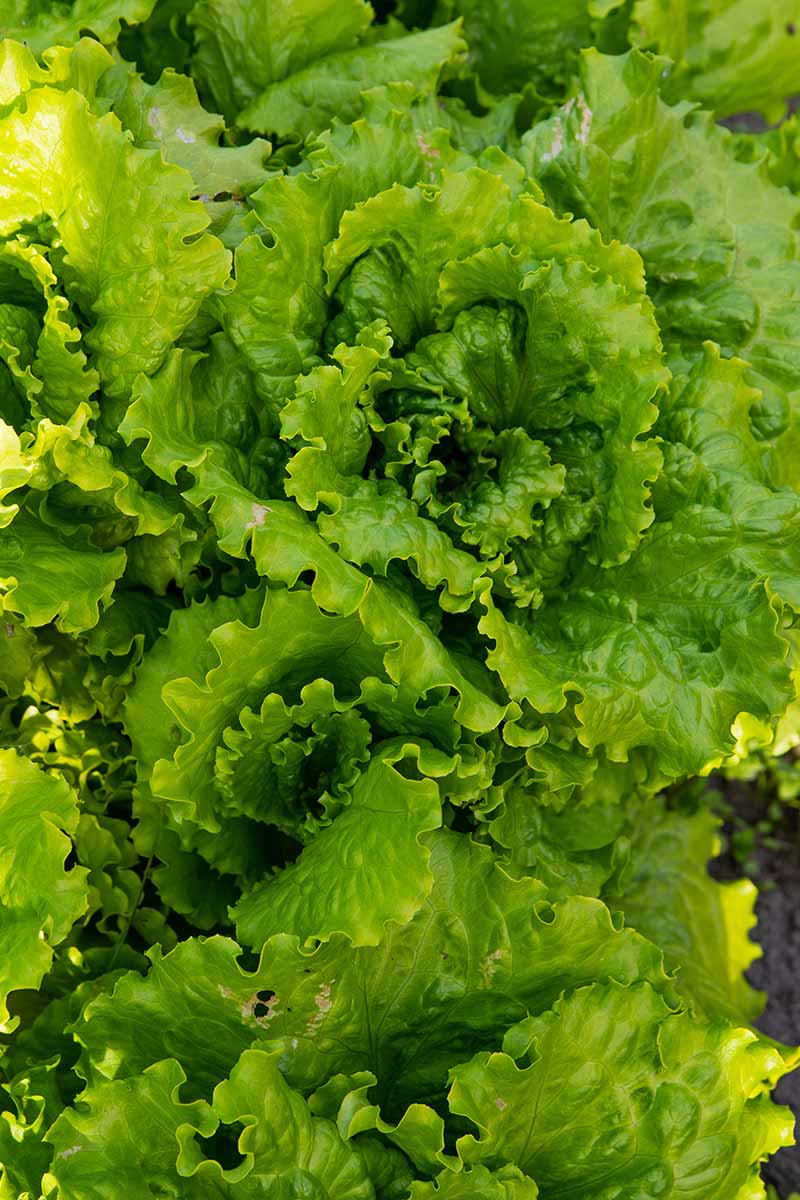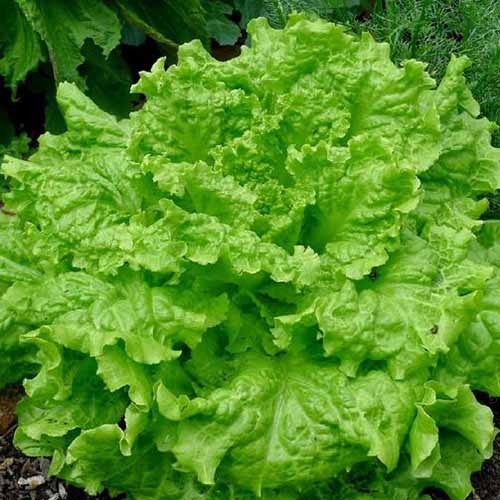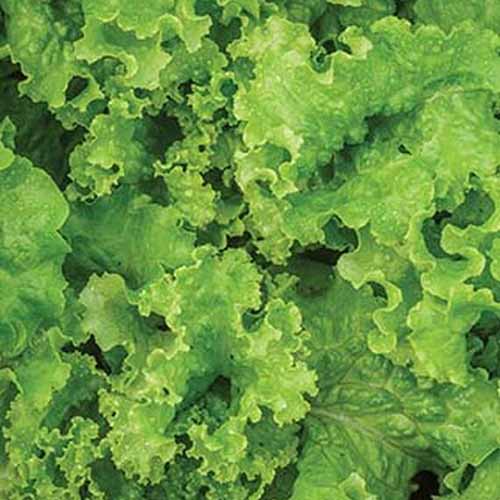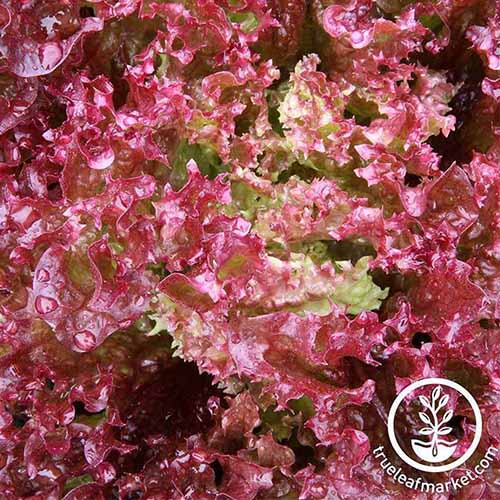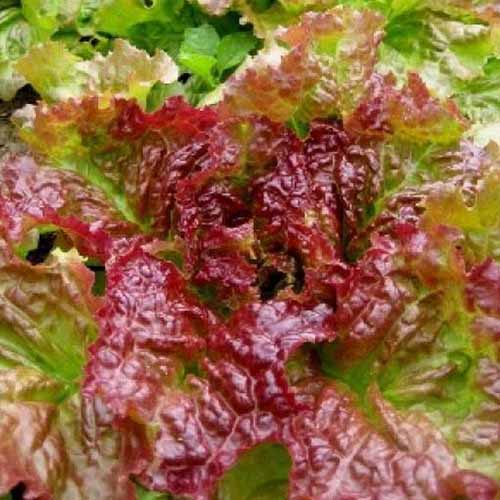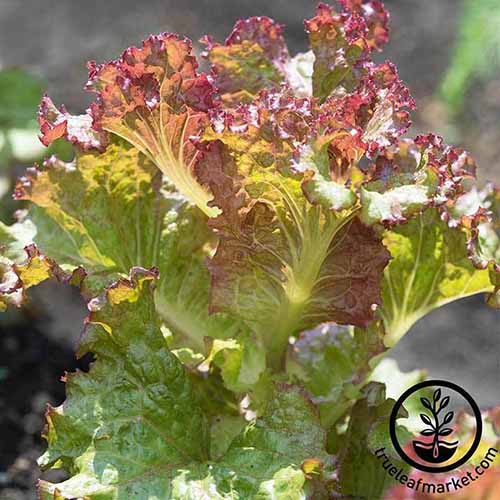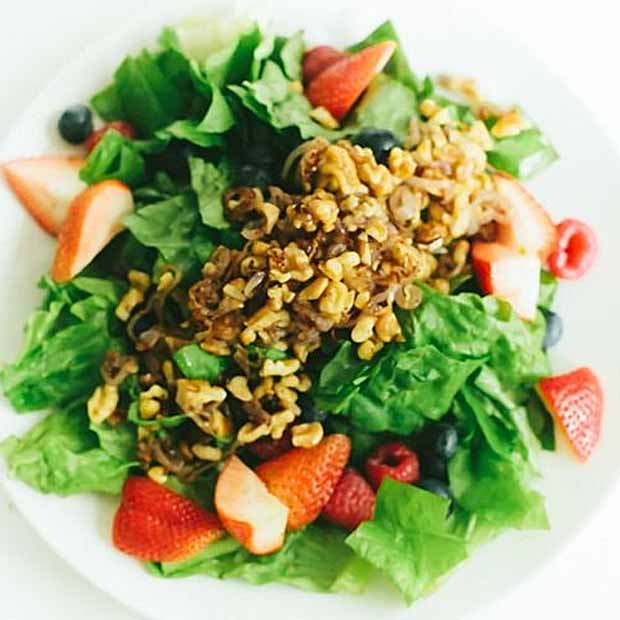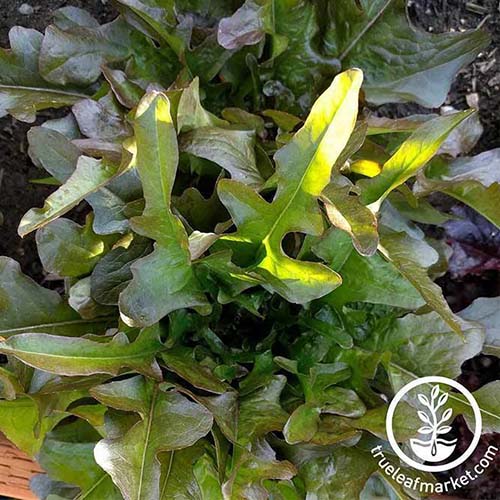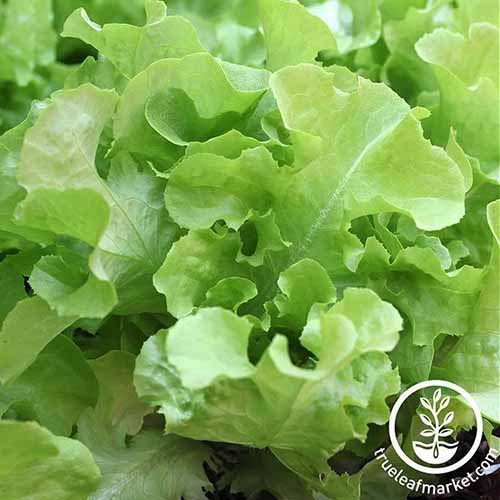With all these choices, even the most ardent veggie-phobes or demanding foodies will find a lettuce to love. Most of the leafy greens we put in our salad bowls are varieties of Latuca sativa. Have you ever noticed what the flowers look like when your lettuce goes to seed? They might remind you of ornamental asters – and for good reason, as these plants are members of the Asteraceae or aster family. We link to vendors to help you find relevant products. If you buy from one of our links, we may earn a commission. Their leaves come in different shapes, colors, and sizes – and their flowers are yellow or white, like those of their closest wild relative, L. serriola. Let’s take a tour of some of the best varieties of lettuce. I’ve included some popular choices for you to choose from, as well as some lesser-known cultivars.
Crisphead
Let’s start off with a type of L. sativa called crisphead, also known as head or heading lettuce. Does this sound exotic and interesting? Brace yourself. I’m talking about the category that includes good old iceberg.
Crisphead varieties like iceberg may be fairly subtle taste-wise but boy do they have amazing texture, particularly when shredded. As their name suggests, crispheads are crunchy and crisp – and since they are full of water, they are wonderfully refreshing during the sweltering days of summer. While they are generally mild tasting, some varieties have more of a sweet flavor. Why not try tossing some shredded crisphead in with some Thai noodles, or layering it into tacos, as in this recipe for crunchy beef tacos from our sister, site Foodal? The leaves of these plants grow in heads – compact round balls – that keep the inner leaves pale and sparkling clean, making kitchen prep easier than it can sometimes be with homegrown loose leaf cultivars. And when you pick a crisphead variety to grow in the backyard, you have a number of choices. ‘Iceberg’ is sometimes pooh-poohed for its low nutritional value, but red crisphead varieties will bring a bit of added nutrition along with their crunch. The red compounds in vegetables such as red crispheads contain anthocyanins, which have multiple health benefits according to studies such as this one in Food and Nutrition Research by H. E. Khoo and fellow authors. Red cultivars can be a little harder to find, but heat resistant varieties are widely available. Here are some of my favorites:
1. Crisphead Great Lakes
First introduced in 1941 by the USDA and the Michigan Agriculture Experiment Station, ‘Crisphead Great Lakes’ was an All-America Selections winner in 1944. This green cultivar is heat resistant, bolt resistant, and is mature and ready to harvest in 80-90 days.
‘Crisphead Great Lakes’ This variety produces dense 8- to 12-inch heads with serrated outer leaves and a tight, crunchy heart. ‘Crisphead Great Lakes’ is available in seed packets of various sizes at True Leaf Market.
2. Hanson Improved
Maturing in 75-85 days, ‘Hanson Improved’ thrives in full sun and partial shade. With green, curly leaves on the outside and a crisp white heart, this variety is also known as ‘Ewing’s Excelsior,’ ‘Gardener’s Favorite,’ and ‘King of the Market.’ One of the more heat-tolerant varieties, the leaves and heart have a mild and sweet flavor.
‘Hanson Improved’ This heirloom variety originates from Maryland, where it was first grown by the Hanson family. In 1871, Henry A. Dreer, a seed purveyor from Philadelphia, brought it to market with the name ‘Hanson.’ Find seeds for ‘Hanson Improved’ in packets of various sizes from True Leaf Market.
3. Igloo
Another green variety, ‘Igloo,’ with its lightly serrated leaves, is quick to mature in only 70 days. It’s heat resistant, thriving even in the warmer months.
‘Igloo’ ‘Igloo’ has a mild flavor, a crisp crunch, and a mature head size of 8-12 inches. Find seeds in packets of 500 at Burpee for sowing in spring or fall.
4. Webbs Wonderful
An heirloom variety originating in England, ‘Webbs Wonderful’ is heat resistant, and produces firm, sweet-tasting heads of 7-11 inches in diameter. The outer leaves are softly crumpled, surrounding a crisp, pale green heart. Slow to bolt and heat-resistant, ‘Webbs Wonderful’ matures in 72 days.
‘Webbs Wonderful’ This variety was introduced in 1890 by Clarence Webb, an English horticulturalist. You can find seeds in various packet sizes available at True Leaf Market.
Butterhead
Sometimes in life things are named perfectly, and I feel that butterhead is one such example. Butterheads don’t just have a soft, buttery texture – they also have a creamy, buttery taste.
If you happen to know a veggie-phobe, you should try sneaking some butterhead onto their plate. Butterheads have none of the strong, bitter, or pungent tastes that put some people off of eating fresh, healthy greens, and their leaves are soft and tender. And recipes such as this one from Foodal combine this type of lettuce with mellow and fruity ingredients – avocado and mango, in this case – for a salad that tastes truly decadent. The broad, tender leaves of butterheads form a loose head, making it easy to harvest leaves as needed in the garden, cut-and-come-again style. Or, wait until maturity and pick the whole thing.
Also known as Bibb or Boston lettuce, butterheads (L. sativa var. capitata) come in a selection of green and red shades, and most varieties are moderately heat tolerant.
5. Bibb
Probably one of the best known varieties of butterhead lettuce, ‘Bibb’ is named after John B. Bibb, an army officer during the War of 1812. Originally called “limestone lettuce” it was first introduced to the market by Grenewein Greenhouse in Louisville in the 1920s. With its abundance of soft green leaves and a tender pale center, this variety matures in 55-60 days, and outer leaves can be harvested earlier in a cut-and-come-again style.
‘Bibb’ The 8- to 10-inch lightly ruffled leaves form a rosette shape, and are tender and delicate with a mild flavor. ‘Bibb’ prefers a full sun location and is somewhat heat tolerant. Find seeds in a variety of packet sizes from Eden Brothers.
6. Bronze Mignonette
Add some color to your salad with ‘Bronze Mignonette.’ With its soft green leaves tinted with bronze, this heirloom variety was first introduced by the Iowa Seed Company in 1896. Slow to bolt, this heat-tolerant cultivar matures in 65-70 days, with 8- to 10-inch heads and crisp, slightly crumpled leaves.
‘Bronze Mignonette’ ‘Bronze Mignonette’ prefers a full sun location, and will tolerate a light frost. You can buy seeds in a variety of packet sizes from Eden Brothers.
7. Buttercrunch
Tender, crisp, and delicious, award-winning ‘Buttercrunch’ has rich green leaves that are often tinged with red, which form a rosette shape around a loose head. Bolt- and heat-resistant, this easy to grow variety prefers full sun but will tolerate partial shade, particularly in warmer climates. Maturing in 65 days, with 6- to 8-inch heads, you can harvest outer leaves early as a cut-and-come-again crop, should you wish to.
‘Buttercrunch’ An All-America Selections Winner in the edible vegetable category in 1963, ‘Buttercrunch’ was first introduced by Cornell University. Find seeds for ‘Buttercrunch’ in a variety of packet sizes from Eden Brothers or read more about growing it here.
8. Dynamite
This hybrid cultivar is notable for being resistant to aphids, lettuce mosaic virus, and water mold. Soft, overlapping, crumpled leaves form a dense, rounded shape. Maturing in 65-75 days, you can harvest 8 to 10-inch heads with a sweet flavor and crisp, yet delicate texture. Alternatively, start harvesting outer leaves after 40-50 days.
‘Dynamite’ Not as heat tolerant as some of the other varieties described above, it’s best planted in a full sun location in fall or early spring. You can buy packets of 500 ‘Dynamite’ seeds from Burpee.
9. Four Seasons
Also known as ‘Marvel of Four Seasons,’ this French heirloom butterhead variety is especially cold tolerant. Leaves range in color from bronze to red and pale green, and form an attractive rosette shape.
‘Four Seasons’ Ideal for late season harvests of tender, crinkled, sweet-tasting leaves, ‘Four Seasons’ matures in 55 days. Disliking the heat, it has a tendency to bolt in warmer weather. Add ‘Four Seasons’ to your garden now with packets of 500 seeds available at Burpee.
10. Tom Thumb
With diminutive 3- to 5-inch heads, the English variety ‘Tom Thumb’ is ideal for smaller gardens or container growing. Soft, green, crinkled leaves form compact heads in just 50-60 days. With a crisp but tender texture and mild, slightly nutty flavor, mature ‘Tom Thumb’ heads are the perfect size to make a delicious side salad for two people. Tolerant of light frosts, this variety enjoys a full sun location.
‘Tom Thumb’ ‘Tom Thumb’ is one of the oldest US cultivars still commonly available on the market today. It was described and depicted in the French seed company Vilmorin-Andrieux’s illustrated book “The Vegetable Garden,” which was first translated to English in 1885. Find seeds in a variety of packet sizes from Eden Brothers.
11. Yugoslavian Red
If you want your lettuce to look beautiful and taste great, try ‘Yugoslavian Red.’ Ready to harvest after only 55 days, you’ll love the bright green leaves that are dappled with burgundy, surrounding a yellowish-green center. An heirloom variety hailing from the country formerly known as Yugoslavia, this cultivar was introduced to the US in 1987 by the Southern Exposure Seed Exchange. The loose, rounded heads mature to be 10-12 inches in diameter, and the outer leaves can be harvested earlier in the season as a cut-and-come-again crop.
‘Yugoslavian Red’ Happier in cooler temperatures, ‘Yugoslavian Red’ has a tendency to bolt when the mercury rises. You can find packets of 1,300 seeds available at Burpee.
Romaine
As the star of the Caesar salad, romaine (L. sativa var. longifolia) is a familiar sight in the lettuce world.
Also known as “cos,” this long leaved salad green is crisp and crunchy, and usually has a mild, or just slightly bitter taste. In general, romaine cultivars are among the most heat tolerant lettuce varieties. Romaine can be found in varieties that are green, red, bronze, or speckled.
It’s fairly easy to find romaine in the supermarket – but usually only the green variety. If you grow your own, you can put a colorful spin on those Caesar salads.
12. Cimarron
With pale green hearts and burgundy outer leaves, ‘Cimmaron’ is an heirloom variety that dates back to the 1700s. Also known as ‘Red Romaine,’ it has a mild, sweet flavor and crunchy texture. Maturing in just 60 days with 10- to 12-inch-long leaves, this variety looks as good in the garden as it does on the plate! Bolt- and heat-resistant, ‘Cimarron’ is also lightly frost tolerant, and can be harvested early for baby leaves.
‘Cimmaron’ Some sources suggest that this variety has been cultivated in the US since the 1700s, but the ‘Cimarron’ we know today was actually brought to market in 1991 by Dorsing Seeds in Oregon. Find seeds in a variety of packet sizes from True Leaf Market.
13. EZ Serve
Easy to grow and “EZ” to serve, this green variety was introduced by Burpee in 2008. It matures in 65 days, with 8- to 10-inch densely-packed leaves. Quick to prepare, simply snap them off at the base of the stem, and they’re plate-ready (after a quick rinse, of course).
‘EZ Serve’ ‘EZ Serve’ can be grown in full sun or partial shade, and the crunchy stems and crisp leaves have a mild flavor. You can find packets of 500 seeds available at Burpee.
14. Forellenschluss
This heirloom variety hails from Austria, and its may be translated from German to English as “speckled like a trout.” This unusual cultivar has long, bright green leaves with wine-red spots and is also known as ‘Freckles’ or ‘Trout Back.’ Maturing in 50-70 days, this heat- and bolt-resistant variety can be grown in full sun or partial shade.
‘Forellenschluss’ The buttery, tender leaves have a mild, almost sweet flavor and grow to a mature height of 8-12 inches. You can harvest them early if you’re a fan of baby greens. You’ll find packets of 500 ‘Forellenschluss’ seeds available at Burpee.
15. Little Caesar
‘Little Caesar’ has delicate green outer leaves with a light golden center. Smaller than some of the other romaine lettuces, each mature head is the perfect size to make a Caesar salad for two people.
‘Little Caesar’ This variety prefers cooler weather, and is not heat tolerant. Growing to a mature height of 8-12 inches in 70 days, the leaves have a sweet flavor. You can find packets of 700 seeds available at Burpee.
16. Little Gem
With its sweet, nutty flavor and diminutive size, ‘Little Gem’ is the perfect variety for the smaller garden. This heirloom grows up to 6 inches tall, and takes only 50 days to mature – or 30 days, if you harvest baby greens. Described in the UK as a “semi-cos,” this variety resembles a small butterhead lettuce, but there is some disagreement among gardeners about how to classify it. However it is officially classified, it is like a cross between a butterhead lettuce and a romaine. ‘Little Gem’ has soft outer leaves and a tight, dense heart.
‘Little Gem’ Crisp and flavorful, ‘Little Gem’ grows happily in full sun or partial shade, and prefers cool weather. Find seeds in a variety of packet sizes at Eden Brothers.
17. Parris Island
Named after Parris Island, located off the coast of South Carolina, this hybrid cultivar has a pale green heart surrounded by dark green, upright outer leaves. Introduced by the Ferry-Morse Seed Company in 1951, ‘Parris Island’ is a cross between the imaginatively named ‘PI120965’ and ‘Dark Green Cos,’ and was developed by the Agricultural Experiment Station at Clemson College. Noted for its resistance to tip burn, ‘Parris Island’ is bolt resistant and prefers a full sun location.
‘Parris Island’ You can harvest mature 12-inch leaves in 65-70 days, or harvest early for baby greens. The delicate, crisp leaves have a sweet and mild flavor. You can buy seeds in a variety of packet sizes from Eden Brothers.
18. Paris White
‘Paris White’ is a French heirloom variety brought to the US by Thomas Jefferson, and grown at his garden at Monticello. This slow-growing variety matures in 75-85 days. The 10-inch leaves have a crisp texture and sweet flavor. Emerald green outer leaves enclose a pale green heart.
‘Paris White’ This variety thrives in a full sun or part shade location, and can be harvested early for tender baby greens. You can find seeds for ‘Paris White’ in a variety of packet sizes from Eden Brothers.
19. Vivian
‘Vivian’ is the largest of all the romaine lettuces I’ve come across. With tightly bunched 12 to 16-inch leaves and a 6-inch-wide head, you’ll be able to feef Caesar’s army with this variety. The giant leaves mature in 70 days, although you can harvest early for smaller greens.
‘Vivian’ This bolt-resistant variety prefers cool weather and will tolerate a light frost. The wide leaves have a mild, slightly sweet flavor and a delicate texture. Add ‘Vivian’ to your garden today with packets of 300 seeds, available at Burpee.
Loose Leaf
Influenced by the many years that I spent living in France, when I eat salad as a side dish, I usually want it to be fairly simple – just lettuce with some oil and vinegar, that’s it. Loose leaf lettuces are the perfect choice for no-fuss side dish salads such as these.
Loose leaf cultivars generally have a mild, sweet flavor, and a texture that is both tender and toothsome – so these fresh greens may be enjoyed without a lot of adornment. Varieties of this type of lettuce come in shades of yellow, green, red, bronze, and burgundy. Their large, broad leaves are sometimes flat with frilled edges, and sometimes extremely savoyed, or frilly, as is the case with the ‘Lollo Rosso’ cultivar.
Loose leaf types tend to be slow to bolt and heat tolerant, lasting longer into the summer than heading lettuces. The leaves are easy to cut and harvest as needed.
20. Black Seeded Simpson
With slightly ruffled, bright green leaves, this heirloom cultivar was first introduced to the US by Peter Henderson and Company in the 1870s. Fast-growing, ‘Black Seeded Simpson’ matures in just 40-50 days, although you can start harvesting even earlier for baby greens.
‘Black Seeded Simpson’ Its abundant leaves have a crisp, juicy texture, and sweet, mild flavor. This variety is moderately heat resistant, and will tolerate a light frost, making it a versatile addition to your garden. You can find seeds in a variety of packet sizes available at Eden Brothers.
21. Deer Tongue
‘Deer Tongue,’ one of my favorite cultivars, is an heirloom variety with arrowhead-shaped leaves that are delicate and delicious. The leaves grow upwards and form a rosette shape around a central mid-rib. The young, tender outer leaves are milder in flavor than the mature inner ones. Also known as ‘Matchless,’ this heirloom variety is heat resistant, slow to bolt, and will mature in just 46 days. ‘Deer Tongue’ It was first officially documented in 1885 by the New York Agricultural Experiment Station, and is thought to have been brought to the US by English settlers in the mid-18th century.
22. Grand Rapids
A vigorous grower, ‘Grand Rapids’ has bright green, crinkled leaves with frilly edges. Maturing in just 50 days, you can harvest young leaves as early as 30 days after germination. With a crisp, juicy texture, and a mild, slightly sweet flavor, this early-maturing variety prefers cool weather conditions, although it is somewhat heat tolerant, and slow to bolt.
‘Grand Rapids’ This heirloom variety was grown in the late 1800s by Eugene Davis, a farmer in Grand Rapids, Michigan, who propagated it in a greenhouse. He later became known as the “father of the forcing lettuce business.” If you want to add ‘Grand Rapids’ to your garden, seeds are available in a variety of packet sizes at Eden Brothers.
23. Green Ice
With its glossy green, frilly leaves, ‘Green Ice’ has the crunch of a crisphead with the ruffled look of a loose-leaf. Maturing in just 45 days, this variety is heat resistant and slow to bolt. The 12-inch leaves have a crisp, succulent texture and deliciously sweet flavor.
‘Green Ice’ First introduced by W. Atlee Burpee and Company in 1973, this variety is a cross between ‘Fordhook’ and ‘Grand Rapids.’ ‘Green Ice’ is a vigorous grower, and will provide multiple harvests of crunchy greens. You can find packets of 1,000 seeds available at Burpee.
24. Lollo Rosso
This heirloom Italian variety has frilly, wavy, ruffled leaves. Light green stems give way to deep burgundy edges. With a nutty, mildly bitter flavor, ‘Lollo Rosso’ matures in 55-60 days with 6- to 8-inch loose-leaf heads. You can start harvesting baby leaves after just 30 days.
‘Lollo Rosso’ A winner of the Royal Horticultural Society’s Award of Garden Merit, ‘Lollo Rosso’ is slow to bolt, but prefers cool temperatures. You may also see this variety called ‘Lolla Rosso.’ Find seeds in a variety of packet sizes from True Leaf Market.
25. Prizehead
In spite of its name, ‘Prizehead’ is a loose leaf variety, with upright ruffled leaves that are pale green with dark burgundy edges. First brought to the market by W. A. Burpee and Company in 1881, this slow-to-bolt variety matures in 40-50 days.
‘Prizehead’ With a crunchy texture and sweet flavor, ‘Prizehead’ will add color to your garden and your plate. You can find seeds for ‘Prizehead’ in packets of various sizes at Eden Brothers.
26. Red Sails
With large, crumpled leaves that are green at the base and give way to deep red edges, ‘Red Sails’ has a soft texture, and a sweet, mild flavor. An All-America Selections Winner in the edible vegetable category in 1985, this easy-to-grow variety matures in just 45 days. The large leaves grow upright to 10 inches tall, or they can be harvested early for baby greens.
‘Red Sails’ Bolt resistant, ‘Red Sails’ will tolerate a light frost. You can find seeds in a variety of packet sizes available at True Leaf Market.
27. Ruby
One of the most intensely colored lettuce cultivars available, ‘Ruby’ is an heirloom variety with a deep burgundy color and ruffled leaves. It reaches maturity and is ready to harvest in 40-50 days. Slow to bolt, this variety is heat tolerant and will retain its color even in hot weather.
‘Ruby’ Introduced to the market in 1957 by the USDA in Beltsville, Maryland, ‘Ruby’ was an All-America Selections Winner in the edible vegetable category in 1958. You can find seeds for ‘Ruby’ in a variety of packet sizes at Eden Brothers.
Oak Leaf
A distinct type of loose leaf lettuce, oak leaf has a subtle flavor similar to regular loose leaf, but with smaller, deeply lobed leaves.
These can easily be turned into a salad without chopping or tearing, and they have a delicate, tender texture. I like to use oak leaf lettuce as a neutral backdrop where the toppings are going to steal the show, such as in this recipe from Foodal for a salad loaded with berries and walnuts, finished with a cayenne honey vinaigrette. Like other loose leaf types, oak leaf lettuces tend to be heat tolerant and bolt resistant. The leaves are easy to cut and harvest as needed. Frequently found in shades of green or red, there are also bronze-colored cultivars.
28. Bronze Guard
‘Bronze Guard’ is an oak leaf variety that will give you a slightly bitter but flavorful and juicy harvest. It comes to maturity in 70 days, however you can pick younger leaves after 50 days.
‘Bronze Guard’ Light green with bronze edging, this heirloom variety is heat tolerant and will provide a bountiful harvest to add texture and color to your salads. You can find ‘Bronze Guard’ in seed packets of various sizes from True Leaf Market.
29. Oakleaf
Introduced in 1771 by the French seed company Vilmorin-Andrieux, ‘Oakleaf’ has green, lobed leaves with a delicate, tender texture and sweet, mild flavor.
‘Oakleaf’ Maturing in just 40 days, ‘Oakleaf’ is cold tolerant and heat resistant, providing a bountiful harvest throughout the growing season. Find seed packets of various sizes from True Leaf Market.
Greens to Envy
With so many textures, flavors, and colors to choose from, lettuce makes a wonderful addition to your kitchen garden that will provide you with bountiful harvests of nutritious greens.
Which of these leafy greens are you ready to plant in your garden – or add to your next salad? Let us know in the comments. To learn more about growing lettuce in your garden, try these guides next:
Plant Your Salad Greens Early: Tips for Growing Lettuce and Microgreens How to be Successful with Your Lettuce Patch Grow Leaf Lettuce: Harvest Beautiful, Nutritious Salads from Your Own Backyard How to Identify and Control Common Lettuce Pests
Photos by Fanny Slater, Shanna Mallon, and Raquel Smith © Ask the Experts, LLC. ALL RIGHTS RESERVED. See our TOS for more details. Originally published on February 25, 2020. Last updated on March 13, 2020. Product photos via Burpee, David’s Garden Seeds, Eden Brothers, and True Leaf Market. Uncredited photos: Shutterstock. With additional writing and editing by Clare Groom and Allison Sidhu.
